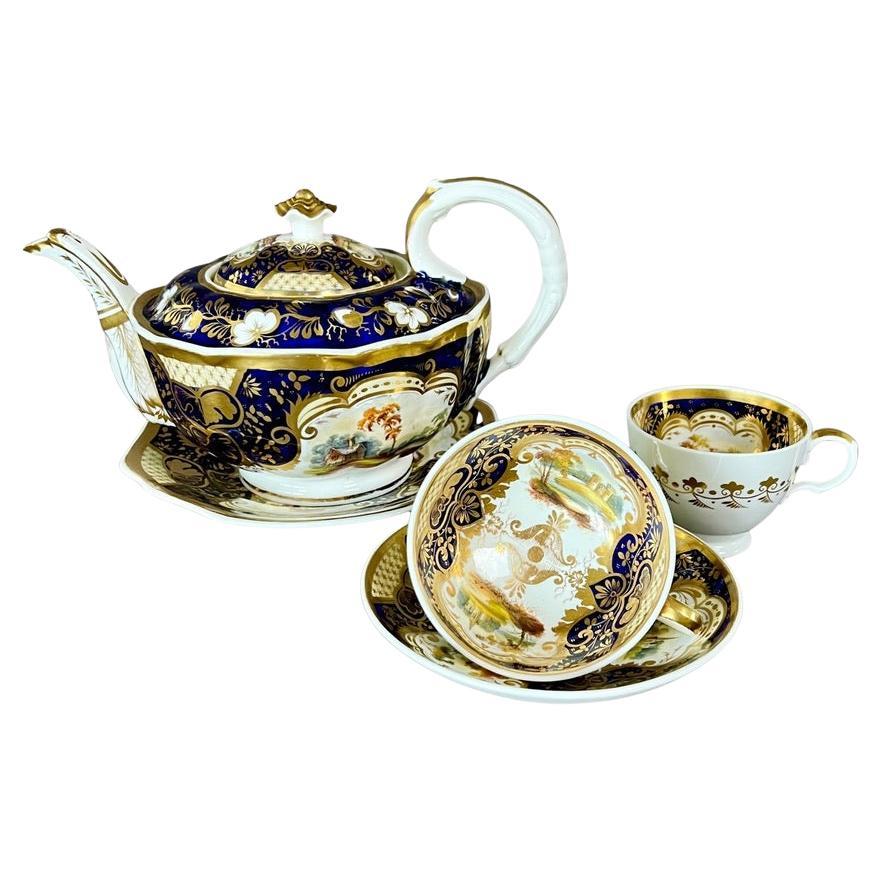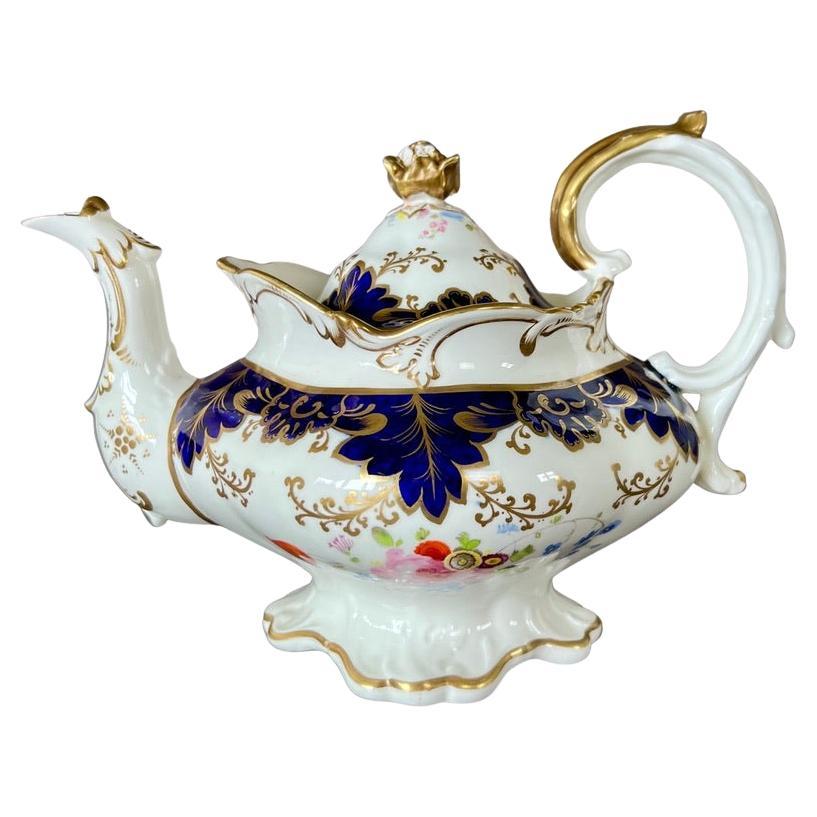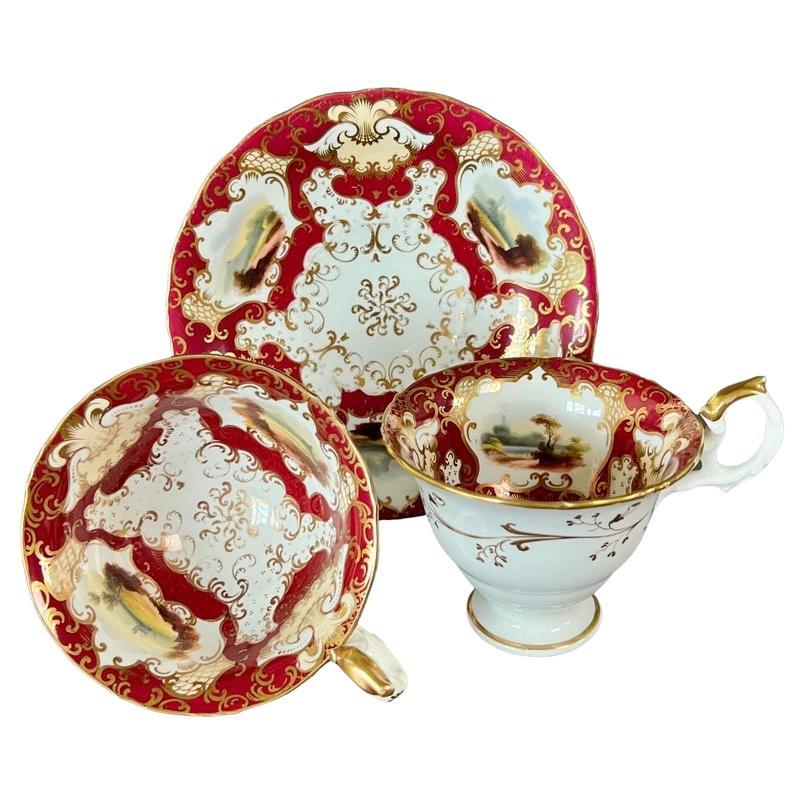Items Similar to Samuel Alcock Solitaire Tea Set, Beige, Pale Yellow and Flowers, ca 1833
Want more images or videos?
Request additional images or videos from the seller
1 of 18
Samuel Alcock Solitaire Tea Set, Beige, Pale Yellow and Flowers, ca 1833
About the Item
A solitaire tea set consisting of a teapot with cover and a trio consisting of a teacup, a coffee cup and a saucer, in “rustic loop” shape, with beige ground with rich pale yellow and gilt acanthus pattern and beautiful flower posies in the centre of each item
Pattern 3801
Year: ca 1833
Size: teapot 25.5cm (10.25”) from handle to spout
Condition: some light crazing and rubbing, some light stress lines in the teapot shoulder and under the spout but probably still good for use, finial has been re-stuck
The Samuel Alcock factory was operative in Staffordshire between 1822 and 1856, after which it was bought by Sir James Duke and Nephews. The factory started as a partnership between the young Samuel Alcock and the older Ralph Stevenson, who provided the factory and capital. Alcock quickly took the factory to great heights, building one of the biggest factories of its time. Alcock jumped on the new Rococo Revival fashion and served a huge new middle class market. The reason we now don't hear much about Samuel Alcock porcelain is that much of it has been mis-identified over the years and attributed to Coalport, Ridgway, Rockingham or others; Alcock did not mark any of his porcelain save a few rare pieces, and the numbering system is difficult to understand. However, the wares are still wide spread and many are of great quality.
This item forms part of the Murray Pollinger Collection of Samuel Alcock Porcelain.
Murray Pollinger was a passionate collector of Samuel Alcock porcelain. He was known as a true gentleman, impeccably dressed, always kind and modest - even some of his porcelain collecting friends had no idea about the size and importance of his collection. From the mid 1980s until shortly before his death in 2022 he collected many thousands of pieces and painstakingly catalogued them. He also went on trips to Staffordshire to discover the history of Samuel Alcock from whatever little documentation has been preserved. Through his painstaking work, Pollinger was able to make sense of the pattern numbering system that was used, and this was a huge step forward in identifying and understanding the porcelain. A website with the results of his research will be made availabe over the course of 2023. While he sold off about half of his collection in 2016, the remaining half is now made available to a new generation of collectors.
Antique British porcelain is never perfect. Kilns were fired on coal in the 1800s, and this meant that china from that period can have some firing specks from flying particles. British makers were also known for their experimentation, and sometimes this resulted in technically imperfect results. Due to the shrinkage in the kiln, items can have small firing lines or develop crazing over time, which should not be seen as damage but as an imperfection of the maker's recipes, probably unknown at the time of making. Items have often been used for many years and can have normal signs of wear, and gilt can have signs of slight disintegration even if never handled. I will reflect any damage, repairs, obvious stress marks, crazing or heavy wear in the item description but some minor scratches, nicks, stains and gilt disintegration can be normal for vintage items and need to be taken into account.
There is widespread confusion on the internet about the difference between chips and nicks, or hairlines and cracks. I will reflect any damage as truthfully as I can, i.e. a nick is a tiny bit of damage smaller than 1mm and a chip is something you can easily see with the eye; a glazing line is a break in the glazing only; hairline is extremely tight and/or superficial and not picked up by the finger; and a crack is obvious both to the eye and the finger. Etcetera - I try to be as accurate as I can and please feel free to ask questions or request more detailed pictures!
- Creator:Samuel Alcock & Co. (Maker)
- Dimensions:Height: 1 in (2.54 cm)Width: 1 in (2.54 cm)Depth: 1 in (2.54 cm)
- Sold As:Set of 5
- Style:Rococo Revival (Of the Period)
- Materials and Techniques:
- Place of Origin:
- Period:
- Date of Manufacture:circa 1833
- Condition:Repaired: Teapot finial has been re-stuck. Wear consistent with age and use. some light crazing and rubbing, some light stress lines in the teapot shoulder and under the spout but probably still good for use, finial has been re-stuck.
- Seller Location:London, GB
- Reference Number:
About the Seller
5.0
Platinum Seller
These expertly vetted sellers are 1stDibs' most experienced sellers and are rated highest by our customers.
Established in 2016
1stDibs seller since 2019
208 sales on 1stDibs
Typical response time: 1 hour
- ShippingRetrieving quote...Ships From: London, United Kingdom
- Return PolicyA return for this item may be initiated within 14 days of delivery.
More From This SellerView All
- Samuel Alcock Matched Solitaire Porcelain Tea Set, Pink with Flowers, ca 1836By Samuel Alcock & Co.Located in London, GBA matched solitaire tea set consisting of a teapot with cover, a sucrier with cover, a milk jug and a matched trio consisting of a teacup, a coffee cup and a saucer. With pink ground...Category
Antique 1830s English Rococo Revival Tea Sets
MaterialsPorcelain
- Samuel Alcock Solitaire Tea Set, Cobalt Blue, Gilt Vines and Flowers, ca 1825By Samuel Alcock & Co.Located in London, GBA solitaire tea set consisting of a teapot with cover, a milk jug and a small cup and saucer, in “melted snow” shape, the cup with double drop handle, with deep cobalt blue ground, r...Category
Antique 1820s English Regency Tea Sets
MaterialsPorcelain
- Samuel Alcock Teacup and Milk Jug, Pale Yellow, Gilt and Flowers, ca 1824By Samuel Alcock & Co.Located in London, GBA teacup and saucer with milk jug in the “melted snow” shape with double drop handles, pale yellow ground with rich gilt and cobalt blue acanthus pattern and finely painted flower re...Category
Antique 1820s English Regency Tea Sets
MaterialsPorcelain
- Samuel Alcock Porcelain Solitaire Tea Set, Cobalt Blue, Gilt, Landscapes, ca1825By Samuel Alcock & Co.Located in London, GBA solitaire tea set consisting of a teapot with cover on a stand and a trio consisting of a teacup, a coffee cup and a saucer, in “half orange” shape with deep cobalt blue and yellow...Category
Antique 1820s English Regency Tea Sets
MaterialsPorcelain
- Samuel Alcock Porcelain Teapot, Blue, Gilt and Flowers, Rococo Revival ca 1837By Samuel Alcock & Co.Located in London, GBA teapot with cover in the “rustic bean” shape, cobalt blue ground with gilt acanthus motif and finely painted flower posies on the belly of the teapot Pattern 5782 Year: ca 1837 Si...Category
Antique 1830s English Rococo Revival Tea Sets
MaterialsPorcelain
- Samuel Alcock Tearcup Trio, Maroon, Yellow, Gilt and Fine Landscapes, ca 1845By Samuel Alcock & Co.Located in London, GBA true trio consisting of a teacup, a coffee cup and a saucer, “rustic bean” shape, in deep maroon and pale yellow ground, with gilt and finely painted landscape reserves Pattern 95...Category
Antique 1840s English Rococo Revival Tea Sets
MaterialsPorcelain
You May Also Like
- 2 Antique 19th Century English Samuel Alcock Blue Gold Floral Cups & SaucersBy Samuel Alcock & Co.Located in Dayton, OH"Four piece set of antique mid 19th century Samuel Alcock porcelain tea / coffee cups and saucers featuring turquoise blue with florals and gold gilding. Samuel Alcock (1799–1848) was a leading pottery manufacturer who operated as Samuel Alcock & Co in Burslem, Staffordshire from 1828 to 1859. They were especially noted for ""picture jugs"" modelled and moulded in relief in various ceramic materials, a popular type of object in these years. Samuel Alcock & Co. Alcock was born in Kingsley, Staffordshire. He was the youngest of the nine children of Thomas (1746–1816) and Catherine Alcock (1756–1838). Though from a farming background, he developed an interest in commerce after working with his uncle Joseph Locker, a grocer, tea dealer, provision dealer, chandler and banker of the Market Square, Hanley. His introduction to pottery came when he embarked upon a partnership with Ralph Stevenson of Cobridge, Staffordshire. In 1828, Alcock developed his own business and began work on the Hill Top site in Cobridge. By the 1830s Stevenson employed 600 people at his works. In 1839 he completed work on a large factory, built in the Venetian style, on the junction of Westport Road and Greenhead Street. In November of that year a party to celebrate the opening was held at the George Hotel...Category
Antique 19th Century Victorian Tea Sets
MaterialsPorcelain
- Fine Porcelain Tea and Coffee SetLocated in Antwerp, BEThe beautiful set comprised of a tea or coffee pot, a cream jug and a sugar bowl with lid and twelve cups and saucers, each piece with gilded borders; Portuguese exquisite Porcelain,...Category
Mid-20th Century Portuguese Mid-Century Modern Tea Sets
MaterialsPorcelain
- Kawki Coffee/Tea SetBy LladroLocated in New York City, NYThe Kawki collection is composed of an imaginative, fun and tender coffee set created for Lladró by Polish designer Aleksandra Zeromska. Inspired by Slavic folklore and the author's ...Category
21st Century and Contemporary Spanish Porcelain
MaterialsPorcelain
- Paris Porcelain Tea SetLocated in New Orleans, LAFabulous Porcelain Tea SetCategory
Antique 19th Century French Tea Sets
MaterialsPorcelain
- Classic Italian White and Gold Fine Porcelain Tea SetBy Porcelaine Del SoleLocated in Paris, FRFine Classic Italian white porcelain with gold decor representing elegant 19th century carriages and elegant couples. Set of nine pieces: One teapot, one milk jar, one sugar bowl an...Category
Mid-20th Century Italian Tea Sets
MaterialsGold
- 4-Piece Vintage Japanese Koshiba Tea SetLocated in Los Angeles, CAVintage Koshida tray and teacup set with hand painted maple leaves / Made in Japan circa 1960s Tea cups feature raised embossed lithophane image of Geisha o...Category
20th Century Japanese Porcelain
MaterialsPorcelain
Recently Viewed
View AllMore Ways To Browse
Coalport Teapot
Coalport Saucer
Tea Cup From Japan
Teapot Royal
Mid Century Glass Lidded Bowl
Antique Sterling Sugar And Creamer
Inox Coffee Cups
Sevres Tea Set With Tray
High Tea
Noritake China Tea Pot
P Pastaud
Sasaki Lightning
Silver Batchelor Tea Set
Silver Overlay Demitasse
Takito Made In Japan Tea Cup
Arklow Pottery
Aynsley Bailey
Belleek Neptune Tea Set





